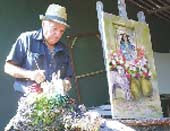Tuesday 12 May 2009
Welcome everyone
In this space you will find information regarding all the meetings, discussions, essays, links that are important in the decision-making process.
It was successful and we had a lot of fun.
Monday 14 April 2008
April 9th to 16th, 2008
Just four things:
1) attached please find results usability testing and formative evaluation (from 3 people)
2) General report was completed with samples (usability testing and formative evaluation)
3) Re: Calendar: I changed color from brown to green of cells frame. However, general color of Google is blue.
4) Re: power point please let me know if you would like to convert it to flash slides shows with slideshares for a better presentation: See explanation
at
http://labnol.blogspot.com/2006/10/convert-powerpoint-presentations-to.html
See you soon,
Nelson
Monday 7 April 2008
Week April 4th to April 9th
http://docs.google.com/
Wednesday 26 March 2008
Week March 17 to March 26th
I worked on the Team site: Wiki. I reviewed my posts during the semester and posted additional ones. I did a survey of pictures or photos for the team's site and I got one, which I sent by e-mail to all members of the team. I also worked or edited the Team’s report: “Saskatoon Council on Aging Website Redesign.” Finally I worked on my
Reading # 3 Article Review
Janice Redish and Dana Chisnell, (2004) “Designing Web Sites for Older Adults:
A Review of Recent Research,” AARP, Washington D.C. 67 pages. Online:
_________________________________
This article is about (main discussion)
- Review recent, relevant research about Web site design and older adults or users. From the research reviewed in this article, the authors developed a set of heuristics to use in person-based, task-based reviews of 50 sites that older adult users are likely to go to.
- It concentrates on research from the disciplines of interaction and navigation, information, architecture, presentation or visual design, and information design. Article includes three sections: firstly, it discusses issues such as who is an “older adult”, what factors besides age must be considered? How these factors been used in research studies? What must be keeping in mind about older adults? Secondly, it deals with “Interaction Design: Designing the way users work with the site.” Thirdly focuses on “Information Architecture: Organizing the content” on Visual Design: Designing the pages, Information Design: Writing and formatting the content, and finally, fifth, it explains how “Conducting Research and Usability Studies with Older Adults.”
- The authors conducted this literature review to (a) better understand the “older adult” audience, (b) identify common usability and design issues specific to older Web users, (c) provide guidance to designers and developers of any Web site or Web-based application who have older adults in their audiences, (d) add information about –e-commerce Web sites and Web transactions to AARP’s Older Wiser Wired (OWW) Web site (www.aarp.org/olderwiserwired)
_________________________________________________________________
The authors argue that:
- Adults are more diverse than younger people are. Within this group, older adults have different experiences and different needs, habits, thoughts, and beliefs. Because of this diversity, it is extremely difficult to generalize performance, behaviours, and preferences to the million of people in a state. Some older adults take technology for granted, but for others using the Web is new territory. People in their 50s and 60s are more likely to have used computers at work. But many older adults – even those who are middle aged – are learning to use computers and the Web on their own.
- The authors propose a new tool that could be used by Web design teams to help them make decisions about where their users fall along these dimensions and thus how best to serve their audiences. The authors’ approach looks at the four factors: (a) age: including chronological age, but taking into account life experiences (b) ability: cognitive and physical (c) aptitude: expertise with the technology (d) attitude: confidence levels and emotional state of mind.
- The implications of those attributes are: those attributes can be used to judge the need for support and training and the level of complexity of features and functions that different users can be expected to handle. That is, increased age is likely to require less complexity, but increased aptitude allows for more complexity. Higher ability (that is, physical and mental fitness) allows for more complexity, and higher ability is likely to also correlate with lower age.
- “User experience” seems to include these qualities: • clear understanding by the site designers and content providers of who the users are (including demographics, domain knowledge, technical expertise, and frame of mind) and why they come to the Web site (tasks, triggers, and motivations) • plain and immediate communication of the purpose and scope of the Web site (as shown through the visual design, information architecture, and interaction design) • compelling, usable, desirable, useful, and possibly delightful content (including tone, style, and depth of content)
______________________________________________________________________
The authors make the following statements or sites the following references on support of their argument (2-3 quotes):
- It takes many roles to design a web site for older adults: DUX, a conference organized by a convergence of professional organizations, suggests that all of these roles (and probably more) contribute to designing the user experience: Authors suggest to view the following site: www.dux2005.org
- The authors suggest viewing Interaction Design Group at http://interactiondesigners.com. Interaction design is “defining the complex dialogues that occur between people and interactive devices of many types— from computers to mobile communications devices to appliances.” Humans and technology act on each other. In the case of Web sites, interaction design determines how a Web site behaves. This behaviour manifests as navigation elements: scrolling, links, buttons, and other widgets, along with how they are placed on a page, what their relationships are to each other on the page, and how easily users can recognize the elements and what the elements will do for them.
- Older participants were very likely to include widgets that were obviously clickable and visually looked like buttons (Chadwick-Dias, Ann with Michelle McNulty and Tom Tullis. “Web usability and age: Howdesign changes can improve performance.” Conference paper, ACM SIGCAPH Computersand the Physically Handicapped, Proceedings of the 2003 conference on universal usability, Issue 73-74).
- The authors quoted 57 references. Among them: Bailey, Koyani, et al. (Bailey, Bob with Sanjay Koyani, Michael Ahmadi, Marcia Changkit, and Kim Harley (NCI). “Older Users and the Web.” Article, Usability University July 2004; jointly sponsored by GSA, HHS and AARP) that found that older users tended to get lost on Web sites much more quickly than younger users “because they were penalized much more by poor labels and headers than were the younger users” and seemed less able to recover from these types of selection mistakes. Because their research shows that Web users skim or scan pages and are attracted to visual elements such as links, Theofanos and Redish suggest using highly descriptive link labels, ensuring that a link will be understandable and useful on its own. They also suggest starting links with relevant keywords and avoiding multiple links that start with the same words. This should help all types of users, not only those who use screen readers or talking versions of Web sites. Theofanos, Mary and Janice Redish. “Guidelines for accessible and usable websites: Observing users who work with screen readers.” Article, Interactions, X (6), November- December 2003, pp 38-51. ACM, the Association for Computing Machinery.
______________________________________________________________
The author concludes that:
Further research is needed to assess the relative importance of the different dimensions in designing Web sites. Older adults exhibit different usage behaviours. Realize that many older adults have cognitive and other medical limitations.
Tuesday 18 March 2008
Week March 12-17 Work contributions from Ottawa
I guess the global prototype is almost ready. For the matrix of contents we might follow June's suggestions in several posts she made in our Client's Portal:
Or if you wish, you may view the menu of my prototype (attached) that includes June's suggestions: you can cut and paste the same matrix or list of topics as she corrected it.
Again, to open my updated prototype you can follow instructions of the link:
http://www.rarlab.com/download.htm
By the way, if you wish to use some other features from it, besides the banner, you are welcome to do it: you can select whatever is useful. Just cut and paste.
Have a nice day!
Nelson















